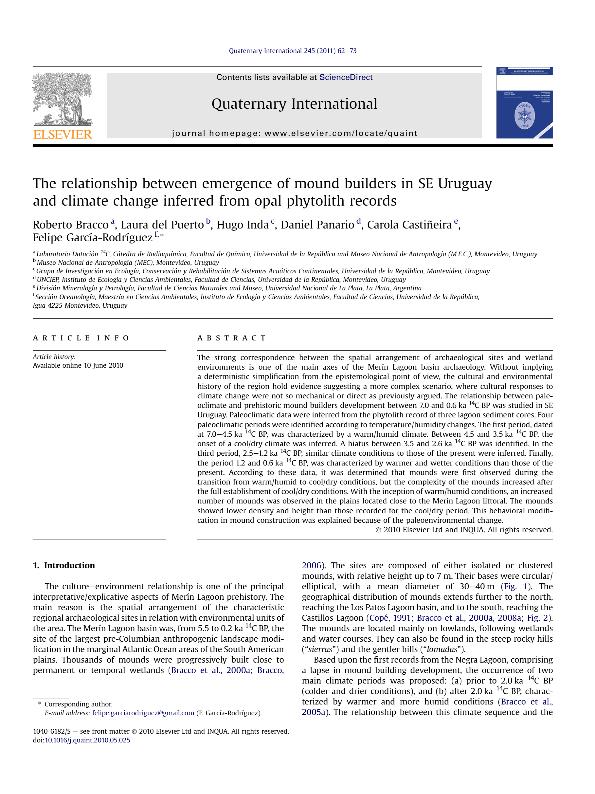Mostrar el registro sencillo del ítem
dc.contributor.author
Bracco, Roberto
dc.contributor.author
del Puerto, Laura

dc.contributor.author
Inda, Hugo
dc.contributor.author
Panario, Daniel

dc.contributor.author
Castiñeira Latorre, Carola

dc.contributor.author
Garcia Rodriguez, Felipe

dc.date.available
2019-08-15T20:20:40Z
dc.date.issued
2011-11
dc.identifier.citation
Bracco, Roberto; del Puerto, Laura; Inda, Hugo; Panario, Daniel; Castiñeira Latorre, Carola; et al.; The relationship between emergence of mound builders in SE Uruguay and climate change inferred from opal phytolith records; Pergamon-Elsevier Science Ltd; Quaternary International; 245; 1; 11-2011; 62-73
dc.identifier.issn
1040-6182
dc.identifier.uri
http://hdl.handle.net/11336/81687
dc.description.abstract
The strong correspondence between the spatial arrangement of archaeological sites and wetland environments is one of the main axes of the Merín Lagoon basin archaeology. Without implying a deterministic simplification from the epistemological point of view, the cultural and environmental history of the region hold evidence suggesting a more complex scenario, where cultural responses to climate change were not so mechanical or direct as previously argued. The relationship between paleoclimate and prehistoric mound builders development between 7.0 and 0.6ka 14C BP was studied in SE Uruguay. Paleoclimatic data were inferred from the phytolith record of three lagoon sediment cores. Four paleoclimatic periods were identified according to temperature/humidity changes. The first period, dated at 7.0-4.5ka 14C BP, was characterized by a warm/humid climate. Between 4.5 and 3.5ka 14C BP, the onset of a cool/dry climate was inferred. A hiatus between 3.5 and 2.6ka 14C BP was identified. In the third period, 2.5-1.2ka 14C BP, similar climate conditions to those of the present were inferred. Finally, the period 1.2 and 0.6ka 14C BP, was characterized by warmer and wetter conditions than those of the present. According to these data, it was determined that mounds were first observed during the transition from warm/humid to cool/dry conditions, but the complexity of the mounds increased after the full establishment of cool/dry conditions. With the inception of warm/humid conditions, an increased number of mounds was observed in the plains located close to the Merín Lagoon littoral. The mounds showed lower density and height than those recorded for the cool/dry period. This behavioral modification in mound construction was explained because of the paleoenvironmental change.
dc.format
application/pdf
dc.language.iso
eng
dc.publisher
Pergamon-Elsevier Science Ltd

dc.rights
info:eu-repo/semantics/openAccess
dc.rights.uri
https://creativecommons.org/licenses/by-nc-sa/2.5/ar/
dc.subject
Mound
dc.subject
Phytolith
dc.subject
Paleoclimate
dc.subject
Uruguay
dc.subject.classification
Historia

dc.subject.classification
Historia y Arqueología

dc.subject.classification
HUMANIDADES

dc.title
The relationship between emergence of mound builders in SE Uruguay and climate change inferred from opal phytolith records
dc.type
info:eu-repo/semantics/article
dc.type
info:ar-repo/semantics/artículo
dc.type
info:eu-repo/semantics/publishedVersion
dc.date.updated
2019-07-17T17:47:30Z
dc.journal.volume
245
dc.journal.number
1
dc.journal.pagination
62-73
dc.journal.pais
Estados Unidos

dc.journal.ciudad
Nueva York
dc.description.fil
Fil: Bracco, Roberto. Universidad de la República; Uruguay
dc.description.fil
Fil: del Puerto, Laura. Museo Nacional de Antropología; Uruguay
dc.description.fil
Fil: Inda, Hugo. Universidad de la República; Uruguay
dc.description.fil
Fil: Panario, Daniel. Universidad de la República; Uruguay
dc.description.fil
Fil: Castiñeira Latorre, Carola. Consejo Nacional de Investigaciones Científicas y Técnicas. Centro Científico Tecnológico Conicet - La Plata; Argentina. Universidad Nacional de La Plata. Facultad de Ciencias Naturales y Museo. División Mineralogía y Petrología; Argentina
dc.description.fil
Fil: Garcia Rodriguez, Felipe. Universidad de la República; Uruguay
dc.journal.title
Quaternary International

dc.relation.alternativeid
info:eu-repo/semantics/altIdentifier/doi/http://dx.doi.org/10.1016/j.quaint.2010.05.025
dc.relation.alternativeid
info:eu-repo/semantics/altIdentifier/url/https://www.sciencedirect.com/science/article/pii/S1040618210002223
Archivos asociados
